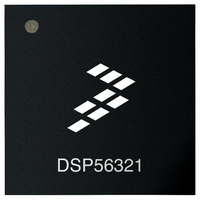DSP56321VF220 Freescale Semiconductor, DSP56321VF220 Datasheet - Page 12

DSP56321VF220
Manufacturer Part Number
DSP56321VF220
Description
IC DSP 24BIT 220MHZ 196-BGA
Manufacturer
Freescale Semiconductor
Series
DSP563xxr
Type
Fixed Pointr
Datasheet
1.DSP56321VL200R2.pdf
(84 pages)
Specifications of DSP56321VF220
Interface
Host Interface, SSI, SCI
Clock Rate
220MHz
Non-volatile Memory
ROM (576 B)
On-chip Ram
576kB
Voltage - I/o
3.30V
Voltage - Core
1.60V
Operating Temperature
-40°C ~ 100°C
Mounting Type
*
Package / Case
196-MAPBGA
Device Core Size
24b
Format
Fixed Point
Clock Freq (max)
220MHz
Mips
220
Device Input Clock Speed
220MHz
Ram Size
576KB
Operating Supply Voltage (typ)
1.6/3.3V
Operating Supply Voltage (min)
1.5/3/3/3/3/3/3V
Operating Temp Range
-40C to 100C
Operating Temperature Classification
Industrial
Mounting
Surface Mount
Pin Count
196
Package Type
MA-BGA
Package
196MA-BGA
Numeric And Arithmetic Format
Fixed-Point
Maximum Speed
220 MHz
Device Million Instructions Per Second
220 MIPS
Lead Free Status / RoHS Status
Contains lead / RoHS non-compliant
Available stocks
Company
Part Number
Manufacturer
Quantity
Price
Company:
Part Number:
DSP56321VF220
Manufacturer:
XILINX
Quantity:
615
Company:
Part Number:
DSP56321VF220
Manufacturer:
Freescale Semiconductor
Quantity:
10 000
Signals/Connections
1.5 Interrupt and Mode Control
The interrupt and mode control signals select the chip operating mode as it comes out of hardware reset. After
RESET is deasserted, these inputs are hardware interrupt request lines.
1-6
MODA
IRQA
MODB
IRQB
MODC
IRQC
MODD
IRQD
RESET
PINIT
NMI
Signal Name
Input
Input
Input
Input
Input
Input
Input
Input
Input
Input
Input
Type
Schmitt-trigger
Input
Schmitt-trigger
Input
Schmitt-trigger
Input
Schmitt-trigger
Input
Schmitt-trigger
Input
Schmitt-trigger
Input
State During
Table 1-8.
Reset
DSP56321 Technical Data, Rev. 11
Interrupt and Mode Control
Mode Select A—MODA, MODB, MODC, and MODD select one of 16 initial
chip operating modes, latched into the Operating Mode Register when the
RESET signal is deasserted.
External Interrupt Request A—After reset, this input becomes a level-
sensitive or negative-edge-triggered, maskable interrupt request input during
normal instruction processing. If the processor is in the STOP or WAIT
standby state and IRQA is asserted, the processor exits the STOP or WAIT
state.
Mode Select B—MODA, MODB, MODC, and MODD select one of 16 initial
chip operating modes, latched into the Operating Mode Register when the
RESET signal is deasserted.
External Interrupt Request B—After reset, this input becomes a level-
sensitive or negative-edge-triggered, maskable interrupt request input during
normal instruction processing. If the processor is in the WAIT standby state
and IRQB is asserted, the processor exits the WAIT state.
Mode Select C—MODA, MODB, MODC, and MODD select one of 16 initial
chip operating modes, latched into the Operating Mode Register when the
RESET signal is deasserted.
External Interrupt Request C—After reset, this input becomes a level-
sensitive or negative-edge-triggered, maskable interrupt request input during
normal instruction processing. If the processor is in the WAIT standby state
and IRQC is asserted, the processor exits the WAIT state.
Mode Select D—MODA, MODB, MODC, and MODD select one of 16 initial
chip operating modes, latched into the Operating Mode Register when the
RESET signal is deasserted.
External Interrupt Request D—After reset, this input becomes a level-
sensitive or negative-edge-triggered, maskable interrupt request input during
normal instruction processing. If the processor is in the WAIT standby state
and IRQD is asserted, the processor exits the WAIT state.
Reset—Places the chip in the Reset state and resets the internal phase
generator. The Schmitt-trigger input allows a slowly rising input (such as a
capacitor charging) to reset the chip reliably. When the RESET signal is
deasserted, the initial chip operating mode is latched from the MODA, MODB,
MODC, and MODD inputs. The RESET signal must be asserted after
powerup.
PLL Initial—During assertion of RESET, the value of PINIT determines
whether the DPLL is enabled or disabled.
Nonmaskable Interrupt—After RESET deassertion and during normal
instruction processing, this Schmitt-trigger input is the negative-edge-triggered
NMI request.
Signal Description
Freescale Semiconductor











